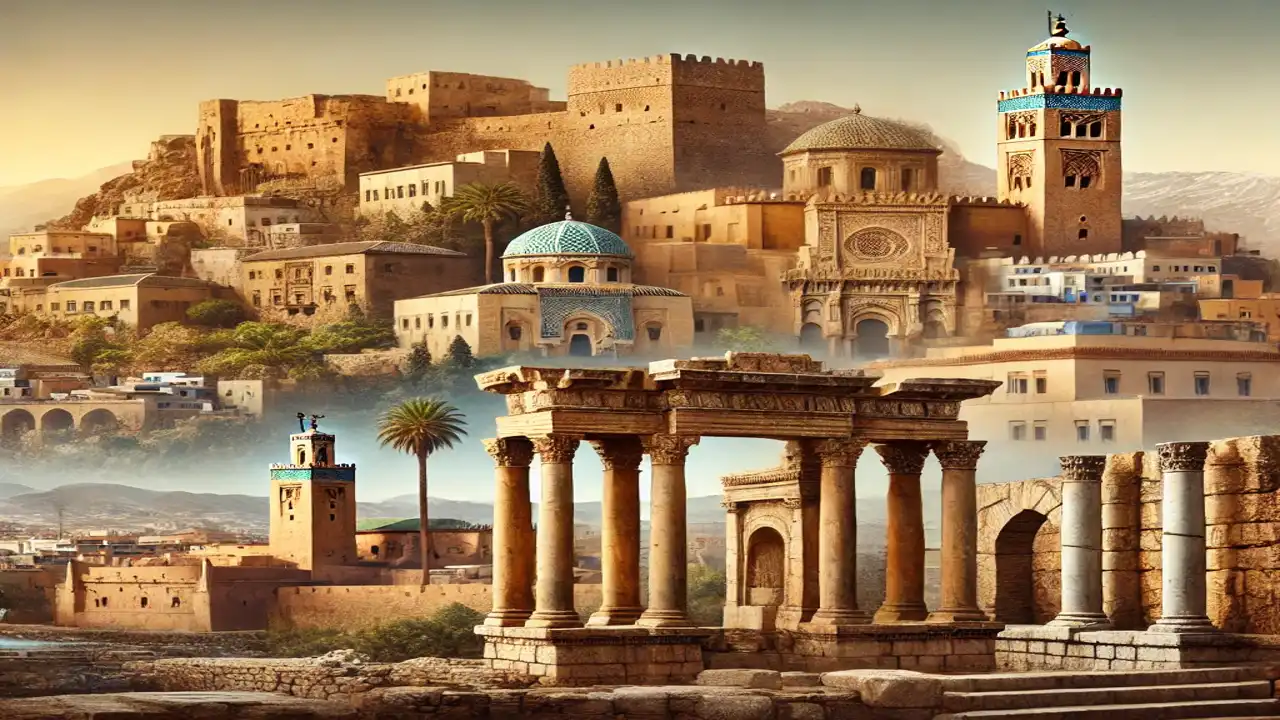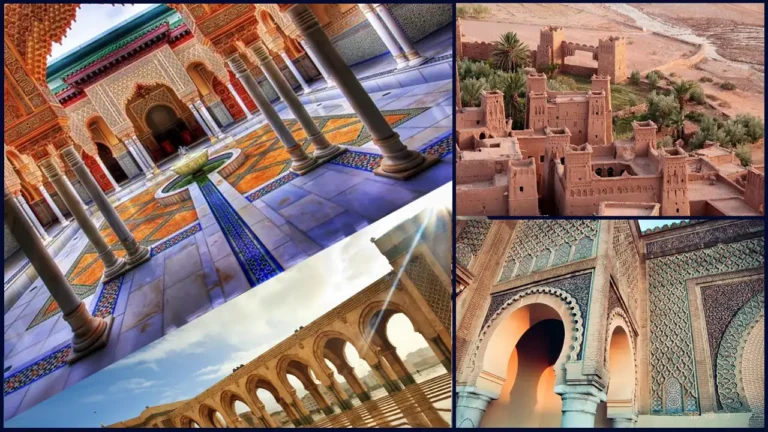History of Morocco: Discover the Legacy of Influence and Transformation
Setting the Scene: History of Morocco as unique!
Morocco is a country with deep roots in history, and a rich and diverse cultural heritage inherited from long influences from Africa, Europe, and the Middle East. Due to its geographical position at the northwest corner of Africa, Morocco has long represented a cultural crossroads where different peoples and civilizations have intersected. From its indigenous Berber roots to the influence of Phoenician traders, the expansion of the Roman Empire, and the Islamic conquests, Morocco’s history reflects a dynamic blend of influences and a residue of all these civilizations had to offer.
The geography of Morocco is as diverse as its history. It expends from the Atlantic Ocean to the Atlas Mountains and the Sahara Desert. This natural diversity has been a cornerstone to Morocco’s influence, either internally or externally. It was the vivid witness of the rise and fall of empires and the blending of cultures, shaping Morocco as it is today.
Table of Contents
Ancient Morocco
The Indigenous Berbers (Amazigh People)
A long time ago, before other civilizations reached Morocco, the Amazigh people—sometimes called Berbers—were already living there. They’re the original people of North Africa, and their culture and language are completely different from the Arabs who came later. The Amazigh didn’t just live quietly; they built the foundation of Moroccan society.
In rural areas, you can really feel their influence—it’s something that stands out in small, everyday things. Even now, their traditions show up in the way people speak, the patterns in their art, and customs that haven’t changed much over time. If you visit the Atlas Mountains or travel out into the Sahara, it’s almost like stepping into a world where their way of life still holds strong. It’s hard to describe, but you’ll know it when you see it. Amazing how it’s all still there, isn’t it?

Phoenician and Carthaginian Influences
By the 12th century BCE, the Phoenicians—seafarers and traders from the eastern Mediterranean—started setting up colonies along the Moroccan coastline. This was the beginning of Morocco’s connection to the wider Mediterranean trade world. Goods, ideas, and cultures began to flow in, creating early networks of exchange. Later on, the Carthaginians, who were descendants of the Phoenicians from what we now call Tunisia, expanded their reach into the region. They boosted trade along the coast and laid some groundwork for interactions that would come later with the Romans.
Roman Period
Roman Rule and the Province of Mauretania Tingitana
By the 1st century BCE, the Romans had taken control of Morocco, turning it into part of the province of Mauretania Tingitana. They didn’t just rule—they brought their own style, building cities, roads, and aqueducts that made travel and trade easier. Volubilis is a great example of what the Romans left behind. These days, it’s a UNESCO World Heritage site, but back in its prime, it was a lively city. It had grand houses, bright mosaics, and public baths where people gathered. Roman rule in Morocco wasn’t as tight as in other parts of their empire, but they still managed to leave behind a lot. You can still spot pieces of their influence if you look closely.
Arrival of Islam and Arab Conquests
The Islamic Conquest and Arabization
In the 7th century, Islam began to spread across North Africa, reaching Morocco and changing life there in big ways. Arab forces brought the religion, and it didn’t take long for many Berbers to start converting. This wasn’t just about religion—it also introduced Arabic as a major language and brought Islamic customs into everyday life. Islam didn’t just arrive in Morocco—it slowly became part of who the people were. It influenced the rules they lived by, the art they made, and even the kinds of buildings you still see today. As it spread, it also set the stage for new dynasties to grow and shape the country’s history in ways that lasted for hundreds of years.
The Rise of the Dynasties
The Idrisid Dynasty: Founding of Fez
Morocco’s first Muslim dynasty, the Idrisids, got its start in 789. Idris I, said to be a descendant of the Prophet Muhammad, fled to Morocco and brought together various Berber tribes under the banner of Islam. He also founded the city of Fez, which would grow into an important center for culture and trade. Before long, Fez became a hub of learning, culture, and trade. The Idrisids helped Morocco create its own unique identity by blending Arab and Berber traditions. Fez grew into one of the most important cities in the Islamic world, known for its scholars, spiritual centers, and vibrant culture.
The Almoravid and Almohad Dynasties
After the Idrisids, Morocco saw the rise of two powerful dynasties: the Almoravids and the Almohads. The Almoravid Dynasty, which ruled from 1040 to 1147, was founded by Berber tribes from the Sahara. They expanded Morocco’s borders and spread Islamic teachings across North Africa and even into Spain. The Almoravids, when they were in charge, decided to make Marrakech their capital. It quickly turned into an important place for culture and politics, and people from all over the region started noticing it. In 1121, though, the Almohads came into power. They ruled for almost 150 years and took a completely different approach. Instead of following what the Almoravids had done, they focused on changing Islam, making it stricter and more unified. The Almohads extended their influence across North Africa and Spain, leaving their mark on Morocco’s architecture. Their grand mosques and palaces are still admired today.
The Saadian Dynasty and the Golden Age
Golden Age Achievements
The Saadian Dynasty, which ruled from the early 1500s to the early 1600s, is often called Morocco’s Golden Age. The Saadian period brought big changes, especially in architecture, culture, and the military. Sultan Ahmed al-Mansur, probably the most famous ruler of the dynasty, left his mark with landmarks like the El Badi Palace in Marrakech. It was a masterpiece of design and detail, showing off the power of the Saadians. Another highlight from this time is the Saadian Tombs. The tilework and stucco carvings are so intricate, it’s hard not to be impressed—they’re a real example of Moroccan craftsmanship at its finest.
The Battle of the Three Kings
The Battle of the Three Kings in 1578 was one of the most important events during the Saadian Dynasty. It happened near Ksar El-Kebir, where al-Mansur led the Saadian forces against the Portuguese. The battle was brutal, ending with three kings dying, including Portugal’s King Sebastian. This victory changed everything. It gave al-Mansur the strength to hold onto power and pushed back European influence. With fewer outside pressures, the Saadians turned their attention to their culture, leaving behind amazing architectural works that still impress people today.
Economic Prosperity
Morocco’s economy flourished during this era. A big part of this success came from controlling trans-Saharan trade, which brought wealth to the kingdom. Much of it came from controlling the trans-Saharan trade routes, which brought wealth and opportunity to the region. The Saadian rulers capitalized on Morocco’s position, trading in gold, salt, and sugar, which generated immense wealth. Ahmed al-Mansur established diplomatic ties with European powers, notably Spain and England, which helped strengthen Morocco’s economy. This period marked a high point in Moroccan influence, and the wealth generated allowed for continued investment in arts and public works.
The Alaouite Dynasty and Colonial Era
Alaouite Foundations
The Alaouite Dynasty began in the 17th century and is still in power today, making it a key part of Morocco’s history. During their rule, Morocco became more unified, with major steps forward in how the country was governed and how it dealt with other nations. The Alaouites spent a lot of time focusing on Morocco’s borders, trying to keep the country safe. At the same time, they had to deal with outside forces, especially France and Spain, who were getting more involved in the region. It was a constant challenge, with tension building year after year.
Colonial Tensions
By the late 19th century, things were getting worse. France and Spain wanted control, and in 1912, they got what they were after. The Treaty of Fes split Morocco between the two powers. France took most of the land, and Spain got the northern areas and parts of the Sahara. Sure, some modern things came along, like better roads and new buildings, but it all came at a cost. Morocco lost its freedom, and decisions were no longer in the hands of its own people.
Impact of Colonialism
The colonial period left a profound impact on Morocco’s economy, culture, and political structure. French influence led to the establishment of new cities and the modernization of infrastructure, including roads, railways, and public buildings. However, the Moroccan people faced restrictions on their freedoms and were subject to policies that favored European settlers. This era sowed the seeds for future independence movements, as Moroccans sought to reclaim control over their land and destiny.
Independence and Modern Morocco
Struggle for Independence
After years of nationalist efforts, Morocco achieved independence in 1956, following a period of peaceful protests and diplomatic negotiations led by figures like King Mohammed V. This movement marked a turning point as Moroccans united to end colonial rule. King Mohammed V, who had been exiled by the French but later restored to the throne, played a pivotal role in the independence struggle, advocating for Moroccan sovereignty on the global stage.
Reign of King Hassan II
King Hassan II, who ruled from 1961 to 1999, sought to modernize Morocco while preserving its rich cultural heritage. His reign was marked by significant economic and social reforms, as well as periods of political unrest. Hassan II aimed to position Morocco as a regional leader, establishing closer ties with Western nations while navigating challenges at home. Despite controversies surrounding human rights, he introduced modernization efforts that would shape the nation’s development for decades.

Reforms under King Mohammed VI
Since ascending the throne in 1999, King Mohammed VI has overseen a period of rapid transformation and reform. His rule has focused on economic growth, social reform, and greater political openness. Initiatives such as the National Initiative for Human Development have targeted poverty reduction and infrastructure improvement, especially in rural areas. Additionally, Morocco has expanded its role in international affairs, working closely with both Western and African nations. Today, Morocco is seen as a stable and progressive nation, blending traditional values with a modern outlook.

A Legacy of Influence and Transformation
Morocco’s history is a story of adaptation and resilience, shaped by a diverse array of influences over the centuries. From its Berber roots to the arrival of Islam, the rise of powerful dynasties, and the challenges of colonial rule, each period has contributed to the unique character of the nation. As Morocco moves forward in the 21st century, its historical journey continues to inform its cultural identity and influence its role on the world stage. Today, Morocco stands as a testament to the enduring spirit of its people, who have navigated the tides of change while preserving the essence of their heritage.






